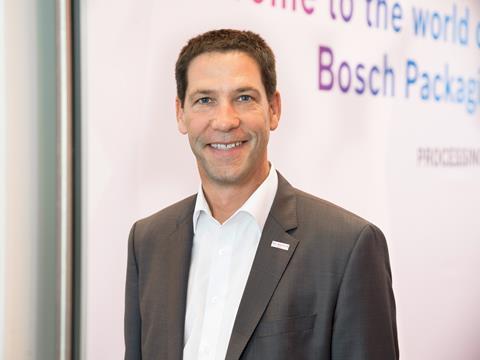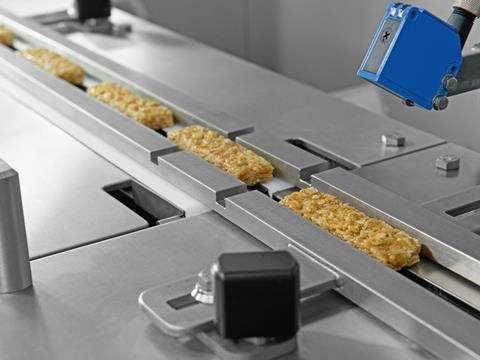
Christian Treitel has been at Bosch for some 25 years, and since 2017 as VP marketing & business strategy at Bosch Packaging Technology, responsible for overall strategy across both food and pharma verticals. Christian talked to Tim Sykes about the intersections of flexibility, output, sustainability and connectivity driving of R&D in packaging lines today.
Is the era of ever higher speed in packaging lines over?
The whole industry is talking about complexity, increasing variety of SKUs, flexibility and small batches. All the hype is around that trend, but there is still significant demand for high-speed production (if not demand to push it still higher) across the food and pharma industries.
This is driven by different factors across food and pharma. If we look at the food market, our customers are experiencing strong cost pressures, and driving efficiency is one obvious way to address this by improving output on their existing lines. If you increase production from 600 to 800 units per minute you gain efficiency: more product from the same footprint and same number of operators.

There’s also a consumer-driven dimension for food manufacturers. For various demographic reasons there is a trend across the market toward smaller packaging formats: bite-size chocolate bars, single portions, etc. Therefore for the same volume of product, food brands have to produce a larger number of packages. This also translates to a requirement for higher operating speeds.
Meanwhile in the pharma market, there is a growing demand for certain basic medication types, for instance paracetamol, at an affordable price. This is an especially big trend in emerging markets such as China, India and Latin America but also to an extent in developed markets. Meeting the requirement for affordability means mass-producing these generic medicines, which creates demand in the marketplace for high-output, high-speed machines, albeit offered at an affordable cost – not ‘Formula One’ equipment.
…But meanwhile much of the market is leaning in the opposite direction?
Yes, on the other hand, there are major contradictory trends. Think of the variety of breakfast cereals people eat today, compared to the past: supermarkets now dedicate metres of shelves to different muesli types in different pack sizes and combinations! E-commerce is offering consumers possibilities that push the market in the direction of individual choices.
In pharmaceuticals there’s the same trend toward smaller batches, driven by new phenomena like more customised treatments and doses, and medications for orphan diseases. Against this backdrop of proliferation of SKUs and individual batch sizes getting smaller, customers are asking for more flexibility.
“With any new idea we need to frankly ask ourselves whether there is a real benefit to the customer. Ultimately, any interface or platform is only as valuable as the content they deliver.”
As such a large provider of technology, we want to provide the whole range from high-speed to medium and low. We like complex problems where we can bring our knowledge to solve our customers’ problems. We also need to follow our customers when, for instance, they realise they need to move from 800 to 400 / minute but with very flexible changeover. Minimising changeover times is one way of making flexible production lines as efficient as possible.
What are the technological challenges that arise when increasing speed and throughput in packaging lines?
We are one of the companies that can master the challenges of working at very high-speeds. Our flow-wrapping lines can handle 1500 bars a minute, and in vertical packaging side we have duplex machines that can produce up to 360 bags. Achieving high speeds involves coping with a number of variables.
One of the most challenging aspects of high speed isn’t the packaging process itself, but ensuring a continuous product infeed. It’s crucial to maintain consistency, which presents complexities from product to product, especially when they are sticky or difficult to handle. You need to make sure you align the product properly. If there are high tolerances in the product – significant variation in size, etc. – the higher the speed, the more issues you encounter.
Another important consideration is the variety of hot seal and cold seal film materials that are used, all with different limitations. In this aspect increasing speed involves conducting tests with customers and defining the right film materials. We also have collaborations with film producers and get early access to their new materials for testing.

Not only when it comes to packaging, but as a whole, sustainability is a complex topic which requires a plethora of expertise. We are convinced that a more sustainable future is a long-term commitment and journey; and we have to be in this together. This is why we seek out long-term partnerships along the entire value chain. For instance, we work together with the packaging material provider BillerudKorsnäs to come up with new packaging solutions that are more sustainable but still optimised for production and functionality.
How does sustainability influence your R&D?
Sustainability is now one of the biggest drivers. One aspect of this is facilitating the transition to more easily recyclable packaging materials. For instance, we’ve introduced paper packaging for sugar and pasta on our vertical machines and are seeking to extend this to other applications. But when our customers change to a different material, they don’t want this to result in lower speeds. Therefore we have to work with them to help them make this transition without losing output. This is a big R&D focus for us at the moment.Similarly, with downgauging or monomaterials in flexible packaging, sometimes new films can be more difficult to handle. We therefore work with our partners and customers to test films and work out how to optimise performance on our machines. There are some films where there are still issues to overcome.

In addition to facilitating migration to more sustainable materials, there are a number of more direct interventions on environmental impact. First of all, we are continuously working on energy consumption. Secondly, we look at ways to help customers to reduce their waste. For instance, we work to ensure all products in infeed are packaged properly in order to avoid product waste, while modern sealing technologies, such as ultrasonic, can reduce film wastage on lines. Perhaps the biggest lever we have is in process technologies where we have some energy reuse concepts already on the market. In sterilising tunnels for the pharmaceutical industry it’s necessary to heat up a vial to 320⁰C and then cool it again. That’s a lot of energy to waste, and in recycling it we can have a big impact.
In what ways are you embracing the Industry 4.0 revolution?
Digitisation is another big topic for R&D, and we’re tackling this on different levels. The first of these is smart machines, where we’re looking at applying Industry 4.0 principles to improve machine output by incorporating additional sensors. We’re working on a number of these projects now.
We also have applications on the market which support operators by making information more easily available to them. After all, maximising output also depends on operating the machinery in an optimal manner. We also have applications to assist with maintenance, guiding the crews with a step by step approach, enabling customers to maximise up-time with the staff they have available.
Meanwhile, in the pharma vertical we have a starter kit that enables customers to connect their data across machines and lines for transparency.
In conclusion, we don’t go for one single Industry 4.0 solution but a bundle of applications to support customers across various topics.
With any new idea we need to frankly ask ourselves whether there is a real benefit to the customer. For instance, over recent years at trade shows you see a lot of hype around AR headsets. We asked whether it was worth doing everything in virtual reality but it’s clear this would be pointless. There are benefits in specific applications, for instance in remote training sessions, but there’s no sense in showing the technology just for the sake of it. Ultimately, any interface or platform is only as valuable as the content they deliver. A search engine is no good without content to search. As an industry, our primary focus should be on solutions, not platforms.
How is innovation strategy structured at Bosch Packaging Technology?
Our approach has been to increasingly focus on industry-specific application know-how and solutions. We don’t aim to produce general-purpose equipment. So we have created dedicated teams with specialist expertise for particular verticals such as frozen foods and confectionery. This enables us to develop specialised solutions to meet the particular requirements of particular product categories, for example hygienic design in frozen food. Our R&D teams are also organised to cater to and raise the bar for industry-specific verticals.
In parallel we are also scouting the market to understand broader demands. For example, we are assessing the extent to which factories could be further automated. We have teams exploring the bigger picture of business development over the horizon: what does the factory of the future look like? Are we likely to see dark factories (personally, I don’t think they will come)? What can we do to optimise flow by eliminating more manual steps? In other industries you see automated vehicles moving around factories. We’re thinking about how we can integrate concepts like this into our business. But this is all at an early stage.
If there were one particular technological bottleneck that you could magically resolve, what would it be?
From a technological standpoint, I don’t see any fundamental barriers to what we want to achieve. Of course, we’re always looking to enhance sealing and improve product distribution. Robotics is an area undergoing big advances.
As a good corporate citizen, I would like to see a breakthrough in sustainability. This would mean the industry as a whole overcoming certain technological challenges, and finding solutions that are not only more sustainable but also affordable for consumers, and therefore spread in the marketplace quickly.














